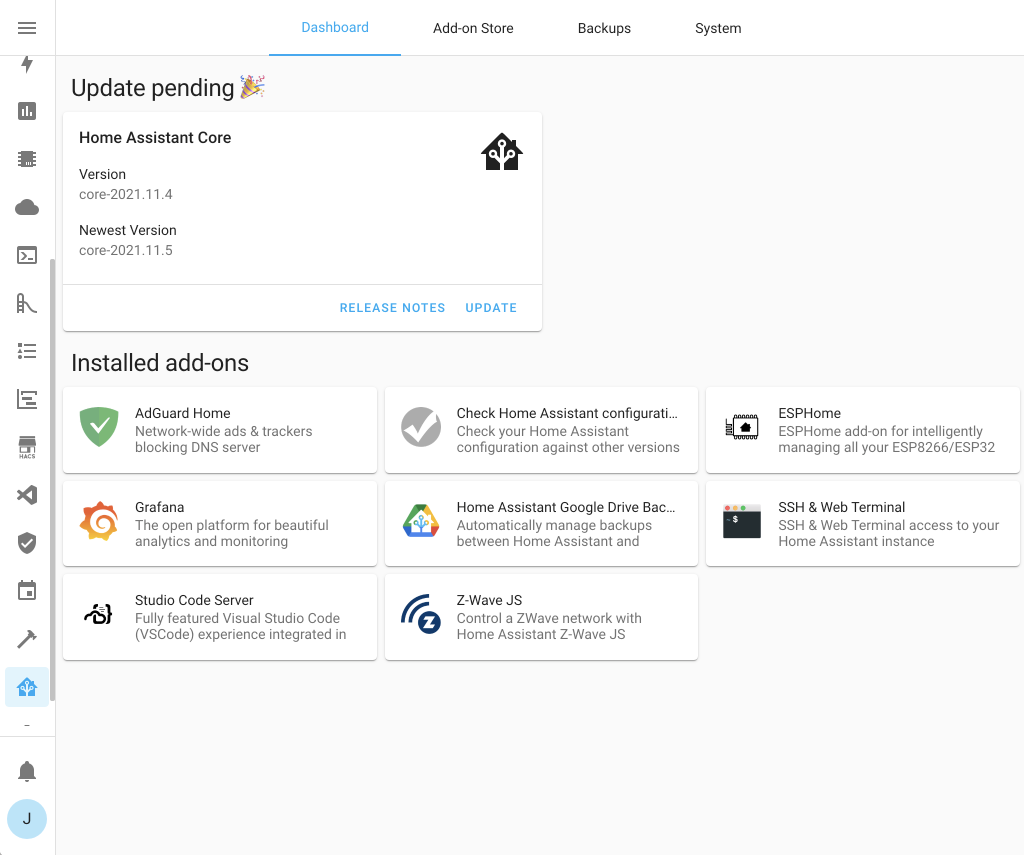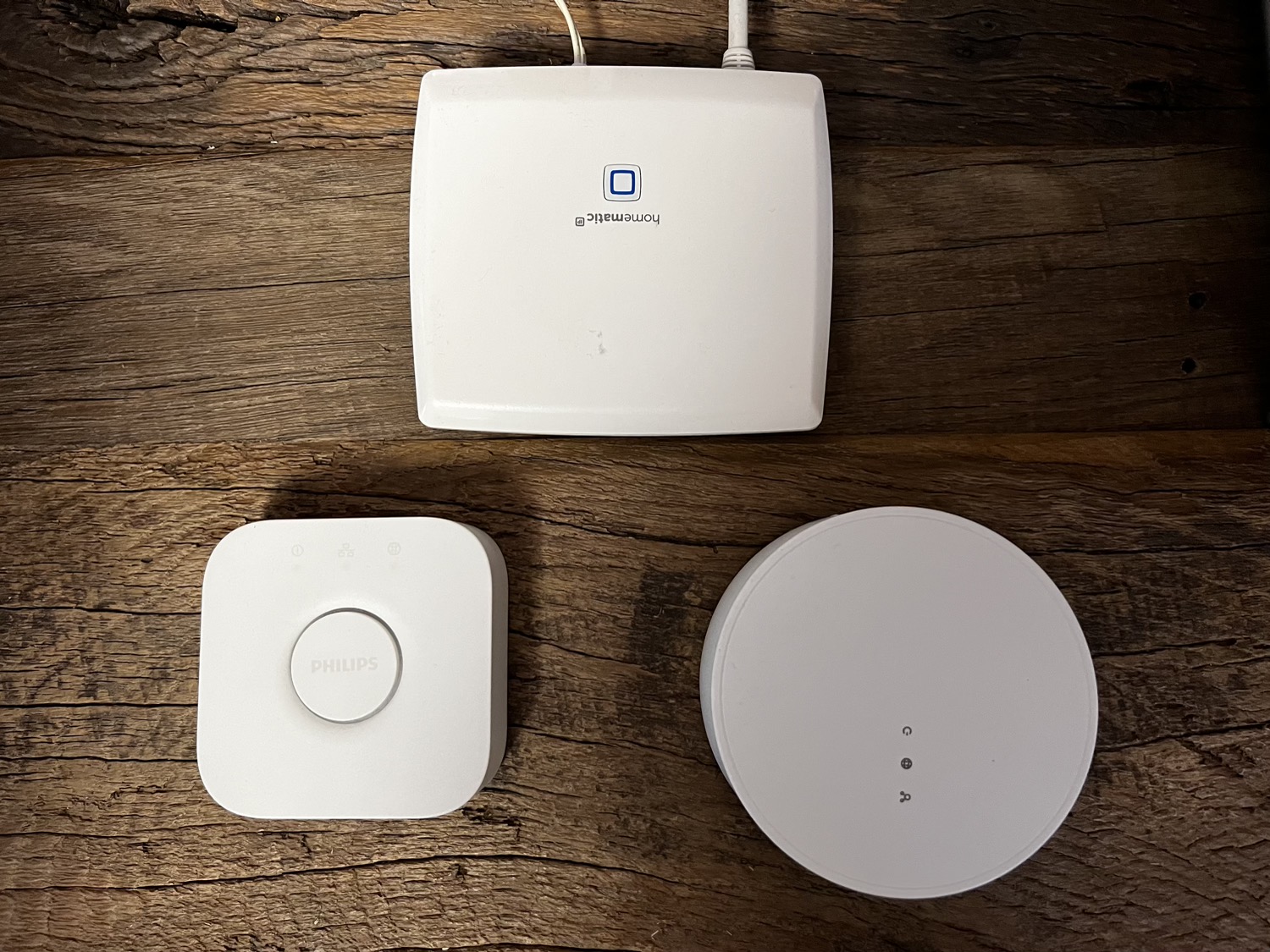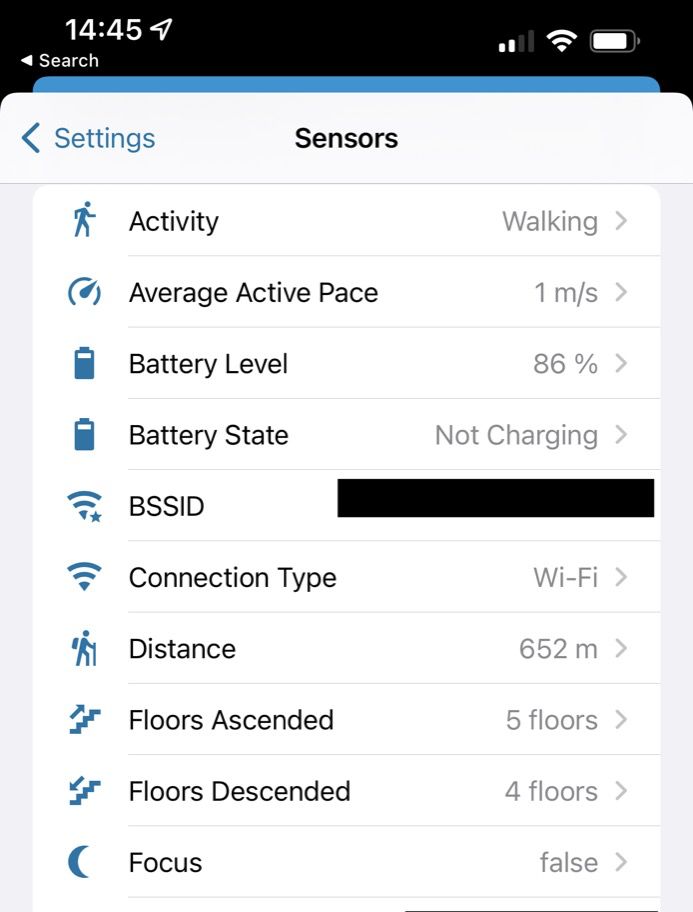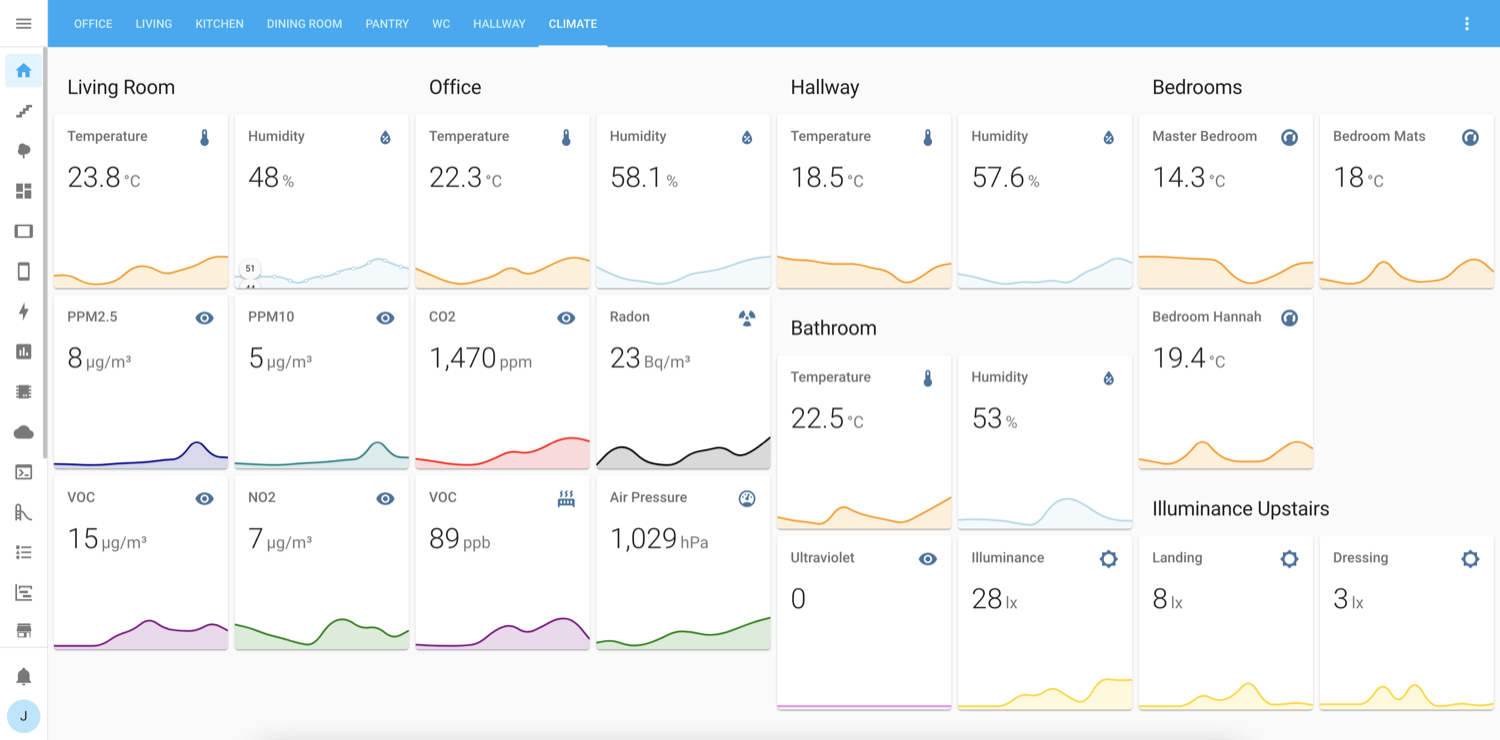It looks like I've linked you here myself. Linking people to a blogpost I wrote is often a bit akward, especially at work.
I likely shared this blog in an attempt to further a conversation. Usually the post does a better job at succinctly sharing information than I could by talking.
In any case, I hope me sharing this post doesn't come across as humblebragging, that's really the opposite of what I'm trying to achieve.
Thanks for reading!
My Smart Home 202112 min read
A Home Assistant Love Story
This post was featured on Hackernews!
It’s been a year since I presented at the first Home Assistant conference and 18 months since I wrote about My Favorite Home Automations. A lot has changed since then - time for an update.
I ❤️ Home Assistant Operating System
.](mbp-server.jpg)
After starting out on a Raspberry Pi, I hosted Home Assistant from this 2011 Macbook Pro - running Ubuntu - for over 4 years. Over the years it also ran a bunch of supporting software: Prometheus, InfluxDB, Logstash, Sensu, Monit, HA Dashboard, Elasticsearch and at least half a dozen others. I’ve kept all the related ansible roles in a legacy folder on Github.
When I started playing with Home Assistant in early 2016, it already showed great potential.
Yet over the years I found myself spending a lot of times working around limitations, writing custom scripts and installing additional supporting software on an old Macbook Pro I had turned into a makeshift server. I even had the entire setup process automated using ansible.
While this worked, this approach was no longer scaling:
- Maintenance time sink: Keeping the whole setup up-to-date started taking a lot of time.
- Divergence: Over time, my setup was starting to diverge more and more from vanilla Home Assistant which became a vicious circle as I tried patching my way around it. It also meant I was missing out on some of the newer, very powerful features (more on that below).
- Aging hardware: Software was sometimes slow due to the older CPU and spinning hard drive.
- Fire Safety: Macbooks aren’t meant to be running for years on end on wall power, often under high load and without additional cooling. I had already been pushing my luck for too long.
Enter Home Assistant Blue 🟦
So when Home Assistant Blue - a compact all-in-one hardware platform running the Home Assistant Operating System - was announced, I was immediately enticed and quickly ordered one. While it took me a few months to find the time and appetite to migrate, I regret not having done so sooner because the difference is so massive.

Home Assistant Blue, banana for scale.
The benefits:
- One-click upgrades: Upgrading has become a single button-click task, often done on mobile and from the couch. I’ve yet to encounter any issue.
- Editing from mobile: The Home Assistant Mobile app is amazing. Not only for controlling, but also for quickly making edits as you think of improvements (from the couch, toilet, bed, on the road. I’ve done all those things).
- Remote control using Nabu Casa: This cloud service to remotely control Home Assistant (from the founders of Home Assistant itself) is great. It works really well, is secure, has been very stable and at 5 USD/month is dirt-cheap for what it provides.
- Home Assistant Add-Ons: The ease of installing and managing other systems like Grafana, AdGuard Home, ZWave JS, VS Studio Code Server (and much more) is awesome. So, much, time and effort saved.
- HACS: Unofficial (i.e. community supported) Home Assistant customization store. This has allowed me to cut back a ton on building my own customizations.
- Google Drive Backups: Given the amount of time I spend on tweaking my Home Assistant configuration, backing it up regularly is critical. This solution works so well it’s worth calling out separately.

Upgrading Home Assistant and managing add-ons is so easy when running Home Assistant Operating System. I’m still getting over how much easier this is than what I had to do in the past.
 front-end customizations I have installed at the time of writing. HACS has made it so easy for people to share their workarounds and dashboard cards, I'm glad I can finally make use of them!](hacs-frontend.png)
HACS front-end customizations I have installed at the time of writing. HACS has made it so easy for people to share their workarounds and dashboard cards, I’m glad I can finally make use of them!
Bye-Bye Hubs 👋, it’s been fun
.](zigbee-network.png)
Visualization of my zigbee network (> 80 devices), using ZHA.
When I started out with home automation in 2016, I wasn’t as savvy nor comfortable going “all in” on Home Assistant without trying it for a while. As a result, I mostly bought smart devices that supported multiple ecoystems (Apple HomeKit, Google Home and Home Assistant) as a way to hedge against Home Assistant not working out.
In practice, this translated to my setup heavily relying on Philips Hue and Ikea Trådfri hubs. While this worked fairly well (and the Home Assistant integrations became a lot more reliable over the years), the indirection of using hubs remained suboptimal. I was also using a few TP Link Wifi smartplugs that I wanted to get rid off.
So earlier this year, I decided to go all-in on Zigbee and re-paired all my devices with a Conbee 2 Zigbee Gateway, while also adding a bunch more sensors and replacing some older bulbs and switches. I also added a few Z-Wave smartplugs for power monitoring use-cases.
Overall, I’m extremely happy with that move and can highly recommend it; in general devices are more responsive and automations more reliable.
On caveat is that I have started running into some reliability issues (occasional device unavailability) once I exceeded 50 or so devices. This seems to be common for Zigbee networks, and I’m still exploring a few options on how to improve that.

Philips Hue (bottom left) and Ikea Trådfri (bottom right) hubs which I’m longer using, together with the Homematic hub I still use for radiator valve control.
. I use Z-Wave instead of Zigbee because Zigbee plugs with power monitoring are not as common and I've read about various reporting issues with them.](aeotec-wallplug.jpg)
For power monitoring use-cases, I use Z-Wave power plugs like this Aeotec Smart Switch 7. I use Z-Wave instead of Zigbee because Zigbee plugs with power monitoring are not as common and I’ve read about various reporting issues with them.
Sensing 📊 and Actuating 🤖
Of course, home automation is all about sensors and actuators. With my full embrace of Zigbee and Z-Wave, I also went on a bit of a sensor purchasing spree: motion sensors, temperature+humidity sensors, door/window contact sensors, leak sensors, power monitoring plugs. While I dream of having every room fully sensorized, it seems I can always think of another sensor to add.
All this data allows for setting up all sorts of useful notifications:
- Door contact sensor: Front door left open for more than 5 minutes!
- Window contact sensor: It’s been more than 2 days since the kids’ bedroom windows were opened, time for some ventilation?
- Motion sensor: Motion detected in the house while house set to Away!
- Cameras: A person detected in the back garden while house set to Away!
- Leak sensor: Leak detected in Laundry room!
- Power Monitoring: Washer/Dryer has finished!
- Temperature sensors: It’s getting cold in the kids’ rooms, maybe turn on central heating?
- Air Quality: The concentration of CO2 is getting high in the office, maybe open a window?
- Vibration sensor: (automation) Dining table chair moved, turn on dining table lights!
- Apple AirTags: Wallet left behind when not at home! (not in Home Assistant)
 Zigbee sensors I use. A big benefit of Zigbee over Z-wave is price. Each of these sensors costs less than 25 EUR, often considerably less when ordered in bulk and/or from China.](aqara-sensors.jpg)
Various Aqara Zigbee sensors I use. A big benefit of Zigbee over Z-wave is price. Each of these sensors costs less than 25 EUR, often considerably less when ordered in bulk and/or from China.

Software sensors for presence detection and more, via the Home Assistant mobile app.
And of course, you can build a bunch of cool dashboards with all that data as well:
. To get this data, I use a Raspberry Pi hooked up to my Smart Energy meter which supports [DSMR](https://www.home-assistant.io/integrations/dsmr/). I'll be switching to [SlimmeLezer+](https://www.zuidwijk.com/product/slimmelezer-plus/) in the near future.](ha-dashboard-energy.png)
Home Assistant 2021.08 (August 2021) introduced energy management. To get this data, I use a Raspberry Pi hooked up to my Smart Energy meter which supports DSMR. I’ll be switching to SlimmeLezer+ in the near future.

Environment dashboard. Usefulness? Limited. Cool-factor? A+ 😎
Sensing is awesome, but where home automation really shines is when it can do physical things around the house. This is an area where I’ve been doubling down, actuating all sorts of things:
- Motion-based lights: The majority of the lights in our home are now motion activated, with smart behavior depending on time-of-day and activity (working, watching TV, eating, sleeping, etc).
- Curtains: The office and hallway curtains are fully automated.
- Window Blinds: Similarly, the office blinds will tilt automatically in the evening or when leaving home.
- Window Opener: The master bedroom window will intelligently open and close based on time-of-day and weather. Detailed write-up.
- Thermostat: These are pretty common, we use a Nest for downstairs heat control.
- Radiator valves: To control the heating of rooms upstairs.
- Air purifier and humidifier: A Dyson Pure Humidify+Cool does automatic air filtering and humidity control.
- Diaper Station: Automated lights based on weight sensing (i.e. when a baby is being changed).
- Bathroom Mirror Heating: A heating pad behind the mirror prevents it fogging up while showering. Pictures in my Home Assistant Conference presentation.
- Boiling water tap: We have a 5-in-1 (warm, cold, cooking, carbonated, filtered) water tap in the kitchen that saves a lot of time when making tea and cooking.
- Smart Sauna: I build a small infrared sauna and equipped it with some smarts.
.](radiator-valve.jpg)
Smart radiator valves, HomeMatic HM-CC-RT-DN.
Smarter Dashboards and Notifications 🔔
As part of my move to Home Assistant Blue, I also fully adopted Lovelace for my wall-mounted control dashboards (running on iPad minis). I had been using AppDaemon HA Dashboard before which served me really well for the last few years, but it’s clear that Lovelace is the superior solution these days (richer widgets, UI editing, less maintenance, frequent updates).
 I had been using for the last few years.](appdaemon-dashboard.jpg)
The AppDaemon HA Dashboard I had been using for the last few years.
 dashboard we use today, annotated.](wallmount-ipad-annotated.jpg)
The main Lovelace dashboard we use today, annotated.
While improving my dashboards is something I want to spent a lot more time on, one thing I’ve been focussing on already is building “smarter” dashboards. Rather than showing dozens of sensors and controls at once, such dashboards only show what’s relevant at the time it is relevant (using a combination of conditional cards, custom button card, card mod).
 (also available for Android).](ios-notifications.png)
Mobile notifications via the Home Assistant mobile app (also available for Android).
To goal here is to avoid dashboard fatigue*,* where you stop looking at a dashboard because it’s always showing the same information. Examples include indicators for trash pickup, open windows/doors, a running dryer/washer and vacation days.
Similarly, I’ve been paying more attention to avoid notification fatigue*,* where I stop looking at notifications on my phone because there’s so many of them and most have become irrelevant (e.g. window opened and closed hours ago). Most of this is done by auto-hiding messages after a few minutes or intelligently cleaning them up (e.g. remove a Window Opened notification when the window is closed).
For device control, I actually try to use the wall mounted dashboards as little as possible, instead relying on automations, voice control and a limited amount of physical (smart) wall switches. Wall mounted dashboards are really cool, but nothing beats a physical switch to toggle lights.
Dashboard building is a bit of a rabbit hole on its own: there are always things to improve. For inspiration, I’ve been looking at ha-floorplan, Dwains dashboard and Mattias Persson’s work.
The State of Home Automation
My personal home automation journey will likely never be done. I’ve got plenty of things on my list that I’d still like to automate: door locks, remaining windows/curtains/blinds, doorbell, sense infuser, garden irrigation, the list goes on. I know what to do to keep busy :-)
Meanwhile, the home automation space is maturing rapidly. Compared to just a few years ago, things have gotten much better:
- Stability and responsiveness: while it still happens daily that a lightbulb or sensor doesn’t properly respond, overall stability and responsiveness has improved massively.
- Standardization: While Matter seems to be perpetually a few months out, the fact that the industry is working towards a single widely adopted standard is a game-changer.
- Smart Device availability: the number of available smart devices has exploded and the prices have come down a lot. Smart lamps and sensors are now plentiful and more approachable solutions are coming to market for things that used to be hard or expensive.
- Influencers: the number of youtube channels, twitter accounts and blogs seems to have exploded. I particularly like The Hook Up and Everything Smart Home, but there are a bunch of others.
Most of all, Home Automation (and Home Assistant) is crossing the barrier where it’s no longer only attainable for IT folk and tech enthusiasts, but becoming mainstream. For me, that’s a child’s dream come through.